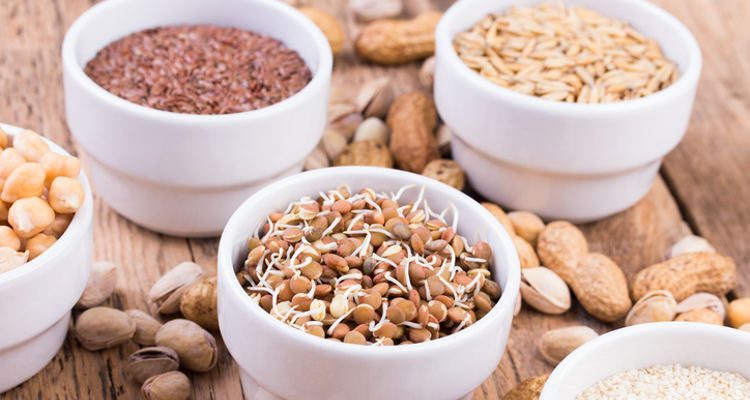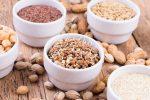
Estrogen is one of two hormones produced in the ovaries that are majorly responsible for sexual and reproductive development in women, though it is present in men in smaller amounts. The other hormone is progesterone. Low estrogen levels are normal in women who have reached menopause or girls who have yet to hit puberty. Additionally, it is normal for women in the reproductive age group to experience low levels of estrogen after childbirth, after every ovulation cycle, and the few days before the beginning of menstrual cycle every month. So, basically, the high-low variation of estrogen and other hormones is only natural during certain phases.
However, many women in the reproductive age group often have low levels of estrogen due to various underlying reasons such as thyroid disease, stress, excess exercise, genetic history, lifestyle and eating disorders, pituitary gland issues, and so on.
Whatever the reason may be, it could be concerning as low estrogen levels are linked to osteoporosis and other orthopedic disorders, heart disease, breast cancer, and other issues. It’s not surprising that many women want to know how to increase estrogen levels naturally.
However, the focus should be on maintaining overall balance of hormones and not just estrogen as imbalance of one affects the other. Luckily, there are high-estrogen foods that may help keep your hormones balanced. We’ve collected information on 10 foods associated with estrogen levels and when you should eat and avoid these “high-estrogen foods.”
10 Foods to Raise Your Estrogen Levels
What foods contain estrogen? The answer is a little more complicated than you might think. The first thing that you should know is that the following high-estrogen foods do not actually contain the hormone estrogen as it’s not a chemical found in nature outside of animals and human beings.
Many of these foods contain phytoestrogen, which is a natural plant estrogen that mimics the effects and properties of estrogen in people.
| High-Estrogen Foods | How These May Help |
|---|---|
| Chickpeas | Chickpeas don’t actually have estrogen, but they do have phytoestrogen, which can provide the benefits of estrogen. |
| Soybean | Soybeans are filled with phytoestrogen. So much so that it is also recommended to avoid them if you have high estrogen levels. |
| Dried Fruits | Dried fruits can also add phytoestrogen to your system, especially dried apricots, prunes, and dates. There is also the added benefit of adding more dietary fiber to the diet. |
| Flaxseed | Consuming flaxseed is one of the best ways to get phytoestrogen into your system as it is easily adaptable. Ground flaxseed can be put into a number of drinks and smoothies or it can be consumed by eating flaxseed bread. |
| Beans | Beans like kidney beans and peas have phytoestrogen in abundance. |
| Tempeh | Tempeh is made from soybeans and a mold (Rhizopus oligosporus) with whole grains. It’s often used as a meat substitute for vegetarians. It’s filled with phytoestrogen and protein. |
| Tofu | Made from soybeans, tofu is another vegetarian staple. It’s made using a different technique than tempeh and also has more phytoestrogen than tempeh. |
| Sesame Seeds | Sesame seeds have a good amount of phytoestrogen, than most seeds except flaxseed. |
| Bean Sprouts | Bean sprouts are a great provider of phytoestrogen and also easy to add to a number of foods like sandwiches and salads. |
| Bran cereal | Bran cereal is not only a good supplier of phytoestrogen, but it also provides a great amount of fiber. |
These foods may help you battle the issues that can occur with a shortage of estrogen. However, it is important to note that research on the benefits of phytoestrogens to humans is not conclusive. In fact, some experts suggest these foods should be avoided under certain conditions. If you have high estrogen levels to begin with, soybeans and soybean products like tofu and tempeh should be avoided.
High estrogen levels can lead to weight gain, hair loss, and have also been linked to breast cancer. Also, food is not the only factor required to balance hormones. Overall lifestyle changes including exercise are necessary. At times, certain hormonal medicines prescribed by your doctor are also essential.
Know the Required Hormone Levels and Symptoms of Low Estrogen Levels
Now that you’ve got a good idea of what foods may help improve your estrogen levels, the next step is to recognize when you may have low estrogen levels. If you are in the reproductive age group and have any symptoms such as irregular periods, insomnia, reduced libido, mood swings and mild depression, hot flashes, facial hair growth, unexplained weight gain & puffiness, and so on, you may have low levels of estrogen or even some other hormones.
If you feel you may be suffering from low estrogen levels, you should always consult your doctor first. Low estrogen can lead to some serious health problems, and any symptoms may be a sign of an underlying health issue. Your doctor may also advise you on the benefits and drawbacks of high-estrogen foods.
Normal levels of estrogen depend on the age of the subject. Women who are 20 to 29 should have an average of 149 pg/ml (picograms per milliliter). From ages 30 to 39, the levels should be around 210 pg/ml but will fall back down to 152 pg/ml at the age of 40 if they are pre-menopausal women.
Women reaching levels of 200 pg/ml will usually require closer examination as it may be an early sign that the subject may have high estrogen levels due to another health concern. Estrogen levels on the low end can go as low as 10-20 pg/ml.
If eating foods with estrogen/phytoestrogen isn’t enough to tilt the required balance in a woman’s favor, there are other options that a doctor may prescribe for treatment like hormone replacement therapy—but only extreme cases.
Keeping Track of Your Estrogen
Keeping track of the body’s chemicals is no easy task. It’s not like many of us have a blood work lab available at home. That being said, estrogen levels are something that you should be aware of. Consuming high-estrogen foods or phytoestrogen foods we have listed in this article may help boost low estrogen levels naturally.
But again, if you start experiencing the symptoms of low estrogen or high estrogen, it’s best to seek the opinion of your doctor. Low or high estrogen levels may indicate underlying problems like diabetes or cancer. The doctor can also tell you the best way to treat your low estrogen levels, and it may be as simple as adding a bowl of bran flakes in the morning to your diet.
Related:
- Sour Stomach Symptoms, Causes, and Remedies: 13 Foods to Ease Upset Stomach
- Top 5 Selenium Foods to Fight Selenium Deficiency
- Top 20 Antihistamine Foods that Help Fight Inflammation
Sources:
“12 Foods High in Estrogen for Balanced Hormones,” Bembu; http://bembu.com/estrogen-rich-foods, last accessed February 17, 2017.
Patisaul, H., Jefferson, W., “The Pros and Cons of Phytoestrogens,” US National Library of Medicine, March 27, 2010, https://www.ncbi.nlm.nih.gov/pmc/articles/PMC3074428/, last accessed February 17, 2017.
“Estrogen Foods List: 50 High Natural Phytoestrogen Sources,” Superfoodly, July 4, 2016; https://www.superfoodly.com/estrogen-foods-list-50-high-phytoestrogen-sources/, last accessed February 17, 2017.
“Normal Estrogen Levels,” New Health Guide; http://www.newhealthguide.org/Normal-Estrogen-Levels.html, last accessed February 17, 2017.
“Low Estrogen,” MD Health; http://www.md-health.com/Low-Estrogen.html, last accessed February 17, 2017.
“6 Signs Of Low Estrogen Levels,” Power of Positivity; https://www.powerofpositivity.com/6-signs-low-estrogen-levels-increase/, last accessed February 17, 2017.
“What Are the Symptoms of Low Estrogen in Women and How Are They Treated?” Healthline; http://www.healthline.com/health/womens-health/low-estrogen-symptoms#Outlook8, last accessed February 17, 2017.













